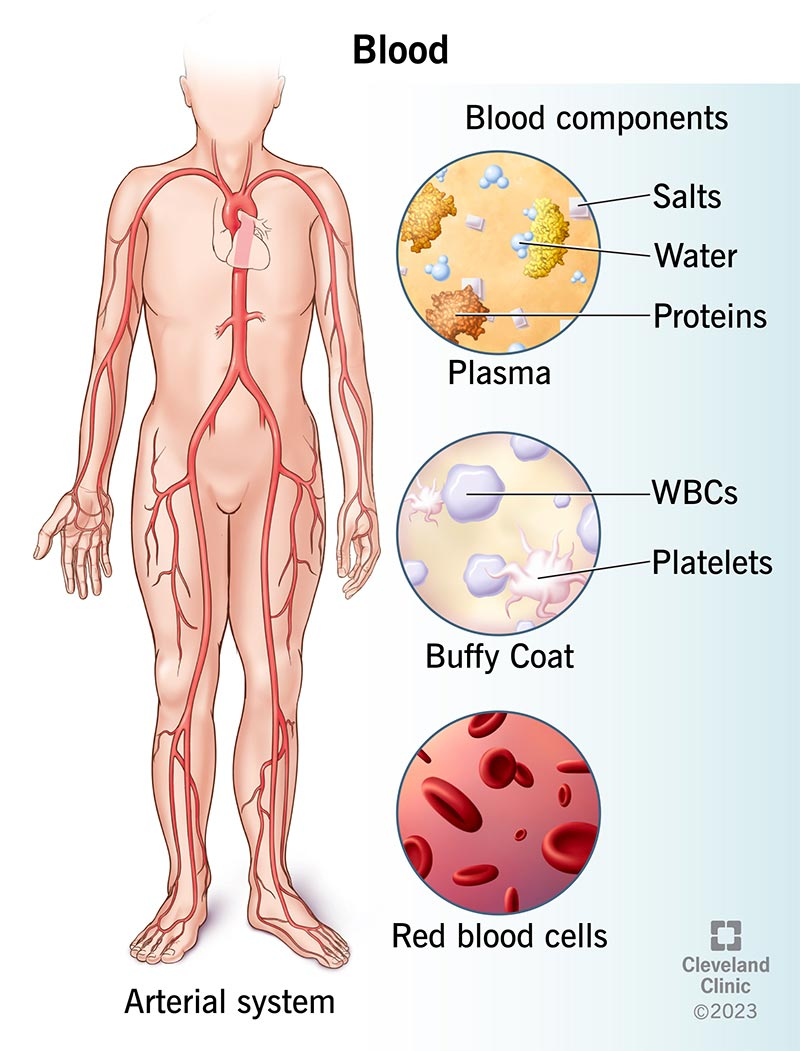Blood is specialized body fluid that constantly flows throughout your body. It does many things to keep your body functioning, such as carrying oxygen throughout your body. Blood cancers and blood disorders may prevent blood from doing its essential work. Healthcare providers have many ways to treat blood cancers and blood disorders.
Advertisement
Cleveland Clinic is a non-profit academic medical center. Advertising on our site helps support our mission. We do not endorse non-Cleveland Clinic products or services. Policy

Blood is an essential life force, constantly flowing and keeping your body working. Blood is mostly fluid but contains cells and proteins that literally make it thicker than water.
Advertisement
Cleveland Clinic is a non-profit academic medical center. Advertising on our site helps support our mission. We do not endorse non-Cleveland Clinic products or services. Policy
Blood has four parts: Red blood cells, white blood cells, platelets and plasma. Each part has specific and important tasks, from carrying oxygen to carrying out waste products.
Your blood also acts like a kind of health barometer. Unusual blood test results may be the first sign of changes that could point to serious illness. This article focuses on how blood works and conditions that affect blood health.
Blood flowing through your blood vessels is responsible for many things:
Blood has four parts. Red blood cells and plasma make up most of your blood. White blood cells and platelets, sometimes referred to as the buffy coat, account for less than 1% of your blood.
Red blood cells (erythrocytes) account for 45% of your blood. They carry oxygen throughout your body. They also help to clear waste from your body. These cells:
Advertisement
Your white blood cells (leukocytes) account for less than 1% of your blood and are part of your immune system. When invaders such as viruses or cancerous cells launch attacks, your white blood cells move quickly to find and destroy them. White blood cells can move from capillaries into your tissues. There are five types of white blood cells:
Your platelets (thrombocytes) are first on the scene any time your blood vessels are damaged and bleeding. Platelets manage bleeding by forming blood clots that seal damaged blood vessels so you don’t lose large amounts of blood. Platelets:
Your blood cells and platelets float in your plasma. Plasma is a yellowish fluid that accounts for 55% of your blood. Plasma is your blood’s utility player, covering many bases as it works to keep your body functioning. Some tasks plasma does include:
There are four blood types. The types are different depending on whether blood contains certain antigens. Antigens are substances that make your immune system react.
Blood flows throughout your body. It gets its start in your bone marrow, which contains stem cells. Stem cells create trillions of cells, including blood cells. Blood cells develop and mature in your bone marrow before they enter your blood vessels. Blood represents about 8% of your body weight.
Blood cancer, blood disorders and a common cardiovascular disease affect blood. Blood cancers affect how your body produces blood cells. Blood disorders keep your blood from doing its job. Atherosclerosis is a cardiovascular disease that affects blood flow. In general, blood cancer and blood disorders have more overall impact on blood health than atherosclerosis.
Advertisement
Blood cancer happens when something disrupts how your body makes blood cells. If you have blood cancer, abnormal blood cells overwhelm normal blood cells. There are three blood cancer types:
Blood disorders are noncancerous conditions that keep parts of your blood from doing their jobs. Blood disorders include anemias, blood clotting disorders and bleeding disorders.
Some blood disorders may not cause symptoms or require treatment. Others are chronic (lifelong) illnesses that require treatment but typically won’t affect how long you’ll live. There are also blood disorders that are serious illnesses and can be life-threatening.
Healthcare providers treat blood disorders by managing symptoms and treating any underlying conditions.
Anemia is the most common type of noncancerous blood disorder. It happens when you don’t have enough healthy red blood cells. Sometimes people inherit anemia, but they may also acquire or develop it. There are many types of anemia. Some common anemias include:
Advertisement
A blood clotting disorder affects your platelets or your clotting factors (coagulation factors). Clotting factors are proteins in your blood that help your platelets manage bleeding. You may develop a blood clotting disorder (acquired blood clotting disorder) or inherit a genetic mutation that causes abnormal blood clotting.
Prothrombin gene mutation and Factor V Leiden syndrome are examples of inherited blood clotting disorders. Antiphospholipid syndrome (APS) and disseminated intravascular coagulation (DIC) are examples of acquired blood clotting disorders.
Bleeding disorders happen when your blood doesn’t clot normally, causing you to bleed more than usual. Von Willebrand disease is the most common bleeding disorder in the U.S. Hemophilia, a rare inherited condition, is another example of a bleeding disorder.
A note from Cleveland Clinic
Your blood is a precious resource, constantly taking care of your body so it works as well as it should. Your blood carries oxygen to your cells so they can create energy. It helps your immune system defend your body against intruders. Blood also manages how much you bleed when you’re injured. While you can take care of your blood, you may not be able to avoid diseases that affect it. Fortunately, healthcare providers can treat most serious blood conditions, including blood cancers and blood disorders.
Advertisement
Last reviewed on 03/17/2023.
Learn more about the Health Library and our editorial process.